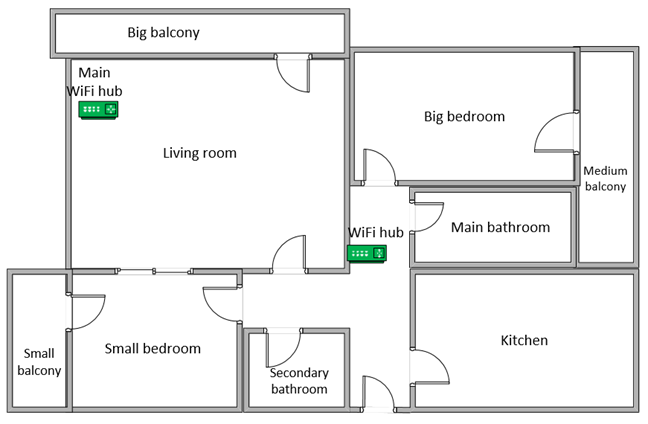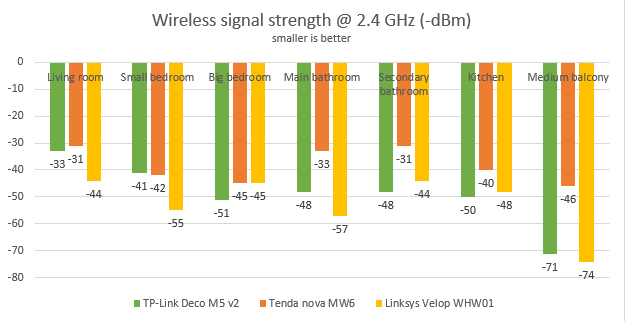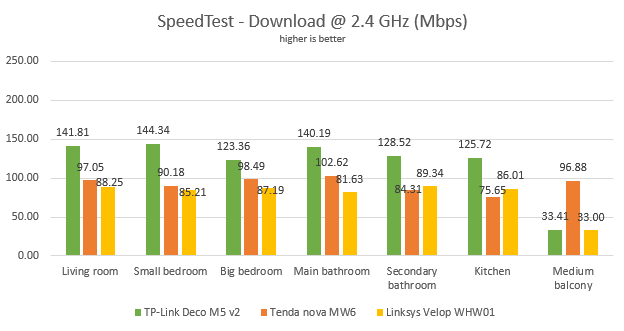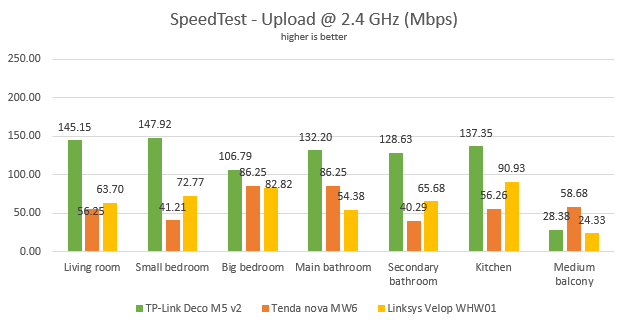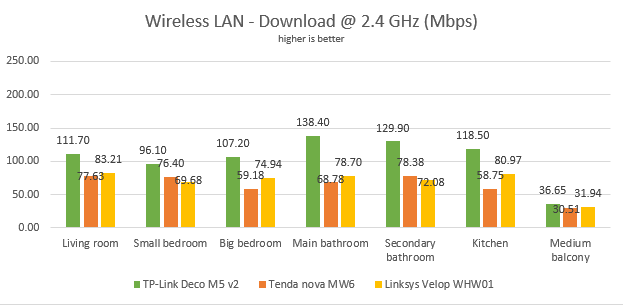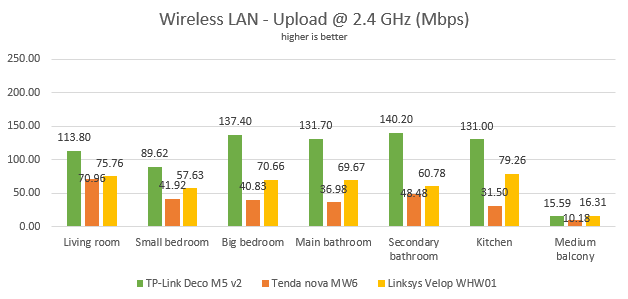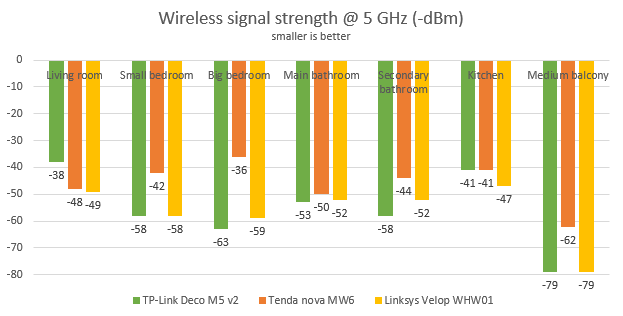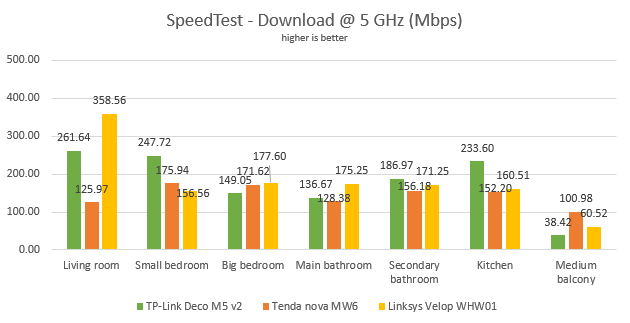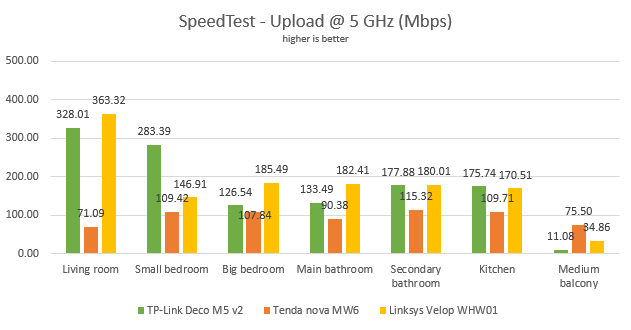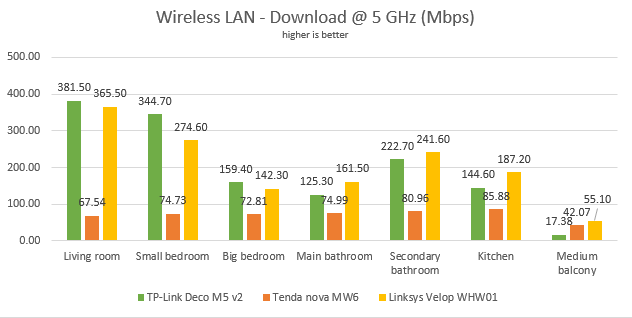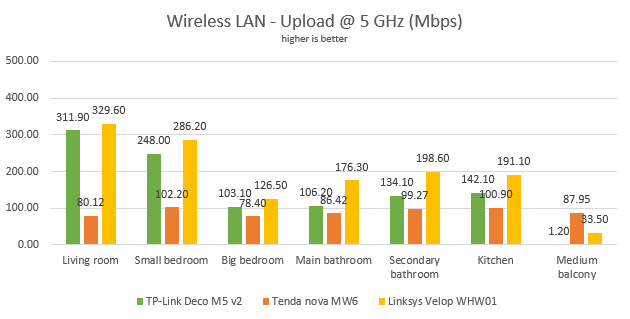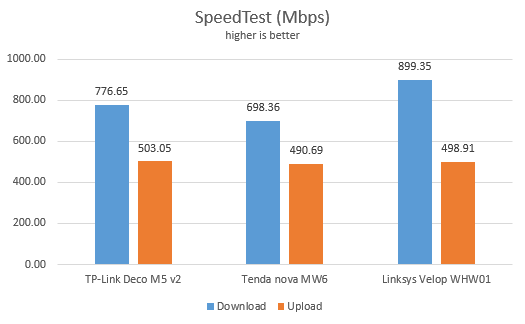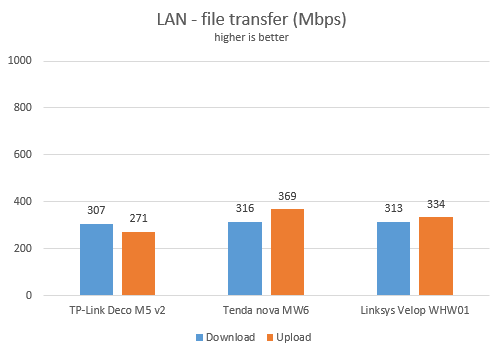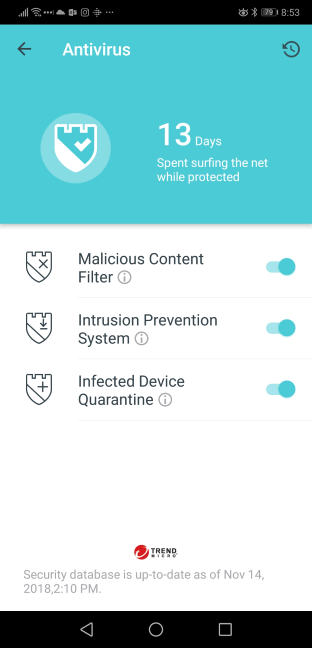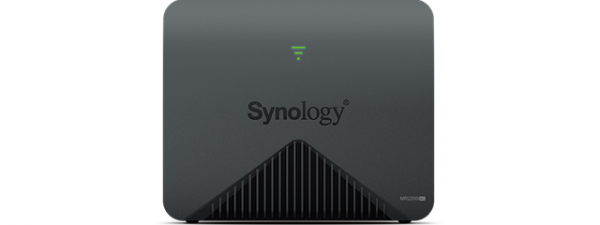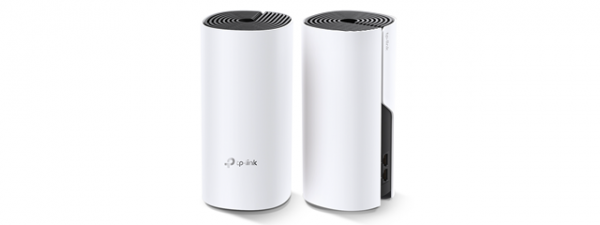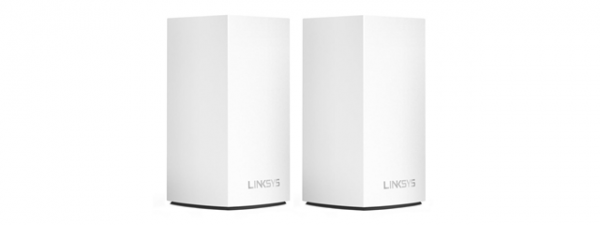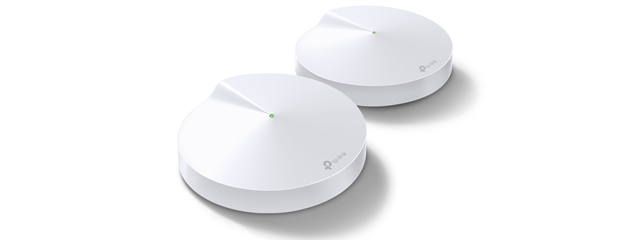
Wireless network performance
First, let's take a look at the apartment that was used in our testing and how it is set up. You can see that the central TP-Link Deco M5 hub is placed in the living room. When using wireless routers, the signal strength is not that high in rooms like the Kitchen and the Medium balcony. To improve the coverage of the network, we placed the second Deco M5 hub in the hallway, close to the entrance to the Kitchen.
Our testing was done using a fast 1 Gigabit Internet connection that is capable of uploads on the internet of up to 500 Mbps. We used an HP Spectre 13 laptop for our measurements.
We decided to compare the TP-Link Deco M5 with Linksys Velop WHW01 and Tenda nova MW6.
NOTE: If you want to learn more about AC notations in networking devices, read this tutorial: What does AC1200, AC1900, AC3200 or more, mean and what's the difference?
We started by evaluating the 2.4 GHz wireless network and measured the signal strength offered in each room, using a tool named NetSpot Pro. As you can see in the graph below, the signal strength offered by TP-Link Deco M5 followed similar trends to that offered by Linksys Velop WHW01, but it managed to be slightly better in most rooms.
Then, we used SpeedTest to see how fast the internet connection is when using the 2.4 GHz wireless frequency. TP-Link Deco M5 v2 was the fastest in our comparison, almost in all the rooms. The reason why Tenda nova MW6 managed to outperform it in the Medium balcony is because Tenda has three nodes instead of two, so it offered better WiFi coverage in our test apartment.
The upload speed followed a similar trend, with TP-Link Deco M5 v2 being the fastest almost in all rooms.
Continuing our measurements on the 2.4 GHz wireless network, we used the PassMark Performance test to transfer data between two computers connected to the network. TP-Link Deco M5 v2 had excellent performance.
The same was true when looking at the upload speed. TP-Link Deco M5 was the fastest device in our comparison.
TP-Link Deco M5 offers good WiFi coverage on the 2.4 GHz band and excellent transfer speeds.
Next, we analyzed the performance offered by the 5GHz wireless network. First, we looked at the evolution of the signal strength, from room to room. The signal strength delivered by TP-Link Deco M5 v2 was OK without being the best.
Next, we ran SpeedTest to see how fast the internet connection is on the 5GHz band. To see the maximum potential of TP-Link Deco M5 v2, we used the world's only PCI-E network card with support for 4x4 MU-MIMO. When we used this network card, we obtained a maximum speed of 386.79 Mbps for the download, and 449.03 Mbps for the upload. These speeds are decent, but other mesh systems are faster in this measurement.
For more down-to-earth results, we also measured the download speed with SpeedTest, in every room of our test apartment, using our HP Spectre 13 test laptop. TP-Link Deco M5 had good performance, without being the fastest mesh WiFi system that we tested.
The same trend was noticed when we measured the upload speed.
For the last measurements on the 5GHz wireless network, we used the PassMark Performance test to transfer data between two computers connected to the network. The performance delivered by TP-Link Deco M5 was better in this test, being close to that of the Linksys Velop WHW01.
A similar trend was noticed when we looked at the upload speed. However, in this situation, Linksys Velop WHW01 was the winner in all the rooms.
On the 5 GHz wireless band, TP-Link Deco M5 v2 delivers balanced performance, that is close to what you get from other top performing mesh WiFi systems.
Wired network performance
To test the quality of the wired Ethernet connection, we used a desktop PC equipped with an AMD Ryzen 5 1600 processor, running at 3.20GHz, 16GB of RAM, a fast Samsung 850 Pro 512GB SSD, and a Lenovo IdeaCentre 610s mini PC.
We measured the speed of the internet connection when using a 1 Gbps Ethernet cable, using SpeedTest. TP-Link Deco M5 v2 delivered good performance, without being the fastest in our testing. As you can see, this mesh WiFi system cannot take full advantage of 1 Gbps internet connections. However, for most people that is not an issue.
Then, we ran a network transfer between the two computers, each connected with an Ethernet cable to a different TP-Link Deco M5. Since the stations were connected wirelessly, the transfer was mediated through WiFi. We used PassMark Performance test for this measurements. Again, Deco M5 delivered good performance, without being the fastest in our testing.
The Ethernet connections offered by TP-Link Deco M5 are not a strength of this mesh WiFi system. Other competing systems tend to perform better.
Extra features
TP-Link bundles some advanced features that are not found on mesh systems from other brands like Linksys or Tenda:
- An antivirus module powered by Trend Micro. It filters malicious content, quarantines infected devices, and it also has an intrusion prevention system that is useful in smart homes. This module works well, but the downside is that you have to pay for it after three years of use. Other devices of this kind offer this feature for the entire life of the device.
- Cloud-based parental controls that are effective and easy to configure. They are useful for setting time limits, schedules, and protecting your children from inappropriate content online.
- You can set managers for your TP-Link Deco M5 mesh, through the TP-Link Cloud accounts. For example, in a family, both the husband and the wife can manage the system from their smartphones and tablets. Again, another useful feature that will be appreciated by some users.
- Integration with Alexa and IFTTT (If This Then That) - you can remote control the Deco M5 using Alexa and voice commands, and set your automation system.
- TP-Link also bundled an easy to configure QoS feature (Quality of Service), that helps you prioritize network traffic based on its type. For example, you can prioritize streaming over downloading files.
The list of features that are bundled with TP-Link Deco M5 is not large. However, what is bundled is useful and works well.
What is your opinion about TP-Link Deco M5?
Now you know our opinion about the TP-Link Deco M5 v2 whole home mesh WiFi system, and how it performed in our testing. Before closing this review, share with us your view of this system. Is it something that you would like to purchase? Would it be useful in your home or workplace? Comment below and let's discuss.


 05.12.2018
05.12.2018 